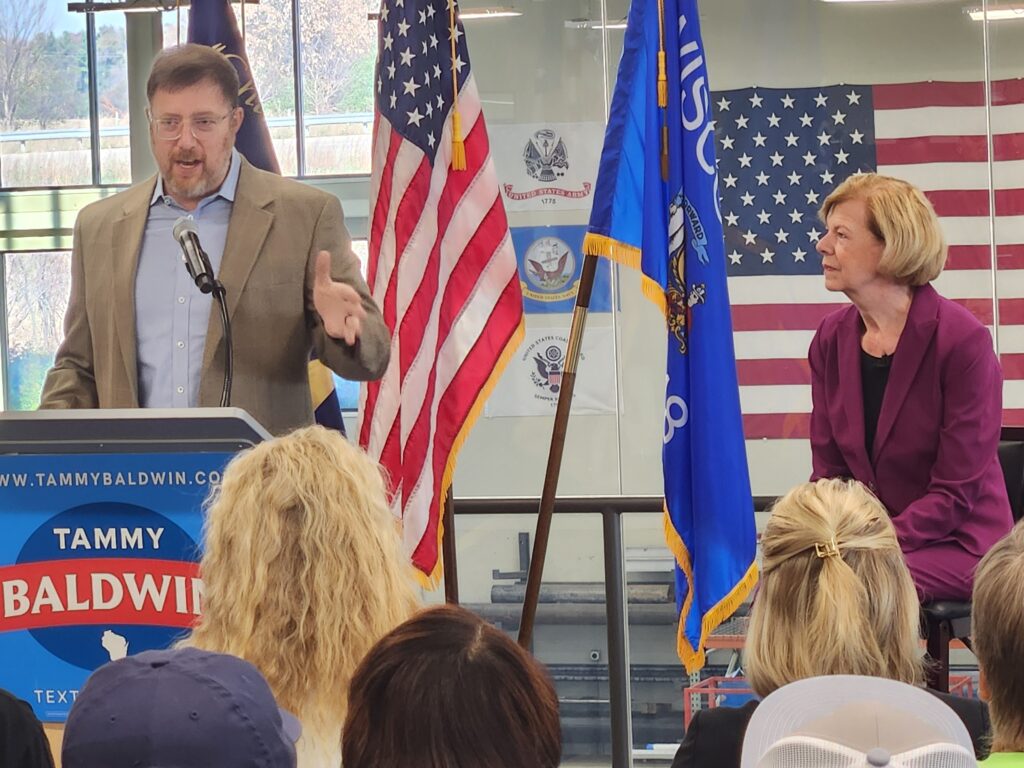
Ben Wikler, chair of the Democratic Party of Wisconsin, introduces Sen. Tammy Baldwin at her victory celebration Thursday. (Erik Gunn | Wisconsin Examiner)
In the midst of a barrage of absurd and appalling news pouring out of Washington, where President-elect Donald Trump keeps topping himself with new, unqualified cabinet appointments, Democrats are looking for hope in Wisconsin.
Two bright lights from our state made headlines after Nov. 5. U.S. Sen. Tammy Baldwin bucked the red wave to win a third term, and Wisconsin Democratic Party Chair Ben Wikler was reported by Politico to be in the running to lead the national party. Baldwin and Wikler share an approach to politics that could help guide Democrats out of the wilderness.
After losing the White House and failing to capture control of either the U.S. Senate or the House (not to mention the likelihood of two new Trump appointments on the U.S. Supreme Court that could create an enduring far-right supermajority), Democrats would do well to look to Wisconsin for a new approach to politics.
In Wisconsin, Trump’s margin of victory — 0.9% of the vote — was the narrowest among the seven swing states he carried. Baldwin, as she has consistently done, made inroads in rural, Republican-voting counties. And Wikler deployed an approach to organizing across rural and urban areas of the state that took no vote for granted.
While extreme polarization and losing touch with working-class swing-state voters are widely counted as prime reasons Democrats lost the 2024 election, Baldwin and Wikler have a recipe for addressing those problems.
“It’s a state where showing up, being present in all different communities, rejecting the kind of false choices that cable pundits might like to inflict on a state like Wisconsin, and rolling up your sleeves can make the difference,” Wikler told me back in 2019, shortly after he moved back to Wisconsin to reenergize the state party. At that moment, Republicans had just lost complete control over all three branches of state government, with the election of Democratic Gov. Tony Evers in 2018. Since then, Wikler has overseen a scrappy fight to claw back power in a state where Republicans, until recently, still dominated politics.
Wikler followed his own advice, opening new field offices across the state. He remained tenaciously upbeat as he steered his party through the rough waters of the pandemic and, in addition to helping elect President Joe Biden and reelecting Democratic Gov. Tony Evers, helped shepherd in a new liberal majority on the state Supreme Court that ended the worst partisan gerrymander in the nation, which had protected a wildly disproportionate Republican legislative majority.
I was impressed by Wikler’s optimism back in 2019, when the gerrymandered maps seemed insurmountable.
He pointed to grassroots organizers all over Wisconsin who were building the case for fair maps, and “getting every elected group of human beings in the state to pass resolutions condemning gerrymandering.”
“All of that needs to clearly lead to electoral accountability for anyone who smashes the idea of representative democracy in the state,” Wikler said at the time. It sounded wildly optimistic. Yet here we are.
Commenting on the eternal debate about whether Democrats need to drive their base to turn out or persuade disaffected centrist Republicans and independents to vote for Democrats, Wikler told me, “in Wisconsin we have to do both.”
“The thing I’m frustrated by every day is the idea that you can’t fight for both white working class voters and voters of color,” he added. “Guess what? There are people of all races in the working class. And all of them want schools and jobs and safe communities and air they can breathe. And none of them like the effects of Trump’s actual policies—even if some of them think they might like Trump as a guy.”
That philosophy is very similar to the politics practiced by Tammy Baldwin, who consistently amazes pundits by winning rural and working class voters even though she is an out lesbian with a strongly progressive voting record. Listening carefully to her constituents and delivering for them, whether through the provision she wrote into the Affordable Care Act that lets children stay on their parents’ insurance until they turn 26, or federal investments in Wisconsin farming and manufacturing, or “Buy America” rules, Baldwin connects with her constituents across the ideological divide.
As Baldwin puts it, “People across Wisconsin want solutions to their challenges and are not all that interested in Republican versus Democrat—they’re interested in who you’ll stand up to, and who you’ll stand up for.”
Wikler agrees: “The key thing to understand is that Wisconsin voters are less centrist than they are conflicted. There’s a populist streak that has both left-wing and right-wing flavors that runs through the state. And the fundamental question that voters are asking is: ‘Is this person on my side?’”
That’s a clarifying vision that could lead Democratic politicians and voters toward a brighter day.
GET THE MORNING HEADLINES.

